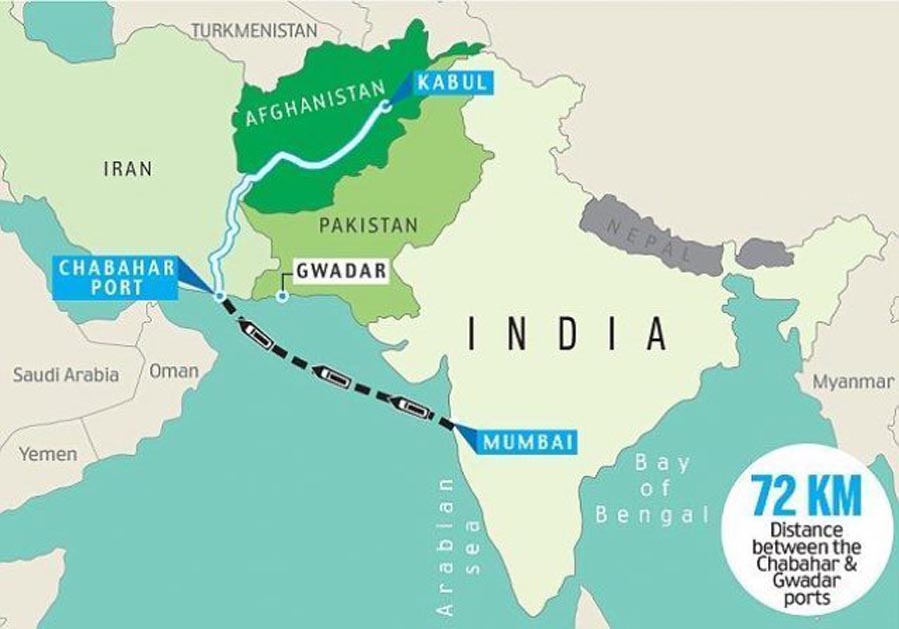Russian, Chinese, American and Pakistani representatives met in Beijing on the 10th and 11th of July to discuss the situation in Afghanistan. This was the third such consultation between Russia, China and the US, and the first in which Pakistan participated. The four party talks, as they were called by the US Department of State, once again exposed the view of the major powers that India has limited significance in shaping the eventual outcome in Afghanistan while Pakistan is inherently important. This is not entirely incorrect. The geography of the region makes it difficult, if not impossible, for New Delhi to influence events in Afghanistan beyond a point.
It is this handicap which India is trying to cut back on by developing the Chabahar Port and gaining access to Afghanistan through Iran. At the time the port project was envisaged, Iran was seen as a friendly power which agreed to the Indian view that the influence of the Sunni radical elements in Afghanistan must be reduced. However, the changed geo-political scenario in the region necessitates India to recalibrate its position on the project.
In 1999, an Indian airplane carrying mostly Indian citizens was hijacked and taken to Kandahar, then under the control of the Taliban regime. The hijacking of the IC-814 airplane had led to humiliation for India. The leadership of the country therefore decided to involve itself more deeply with the developments in Afghanistan. Iran had earlier suffered similar problems as India with the Taliban leadership in Afghanistan when ten of its diplomats were brutally murdered by the regressive regime in 1998 in Mazar-i-Sharif. The Taliban, supported and armed by Pakistan, was seen as a major adversary by both the countries. The meeting of minds of Iran and India on Afghanistan led to the revival of the Chabahar Port project which Tehran had been trying to develop since at least 1973.
As a landlocked state, Afghanistan was completely dependent on Pakistan for trade. By opening up another maritime outlet for trade for Afghanistan, both India and Iran were trying to reduce the negative Pakistani influence in the country. At the same time, Iran also wanted a large port on its relatively underdeveloped eastern region. The new port in Chabahar was expected to spur development in Iran’s Sistan-Balochistan Province. It would provide Iran with a port outside the Persian Gulf and beyond the strategically important but narrow strait of Hormuz. The new port would also reduce congestion in Iran`s only major port, Bandar Abbas.
Apart from accessing Afghanistan, India intended to use the Chabahar Port to reach Central Asia, Asia Minor, Caucasus and beyond. To achieve this, India proposed multimodal transport through the International North South Transport Corridor (INSTC). It was envisaged that Indian cargo would travel by sea, rail and road, through Iran, to markets across Eurasia. India also proposed to develop the necessary infrastructure in Iran to achieve this aim wherever needed.
These plans however hinged on the continuation of good relations between India and Iran. This was a major risk for New Delhi. The ‘mullah-cracy’ in Iran sees itself from the prism of religion. As such, its relations with India were more of friendship of convenience than real convergence of ideas. So long as India was willing to buy Iranian oil, foot the bill for the development of the port and agreed to counteract the Sunni threat to it from Afghanistan, New Delhi was welcome to use Iranian ports and territory. However, things could get messy if the situation changed, as it has now.
The US sanctions on Iran have made cooperation between Iran and India difficult. Tehran is under severe pressure from the US, particularly after President Trump came to office in 2017. The withdrawal of the US from the Joint Comprehensive Plan of Action (JCPOA) has effectively killed the deal. The US has also slapped sanctions on Iran with the aim of reducing its oil exports to zero. This has been followed up with military deployments of the US in the Persian Gulf region. Attacks on oil tankers in the Strait of Hormuz and the seizure of Iranian oil tanker in Gibraltar point to increasing hostility between the US and Iran.
Iran expects India to stand up to the US by continuing to buy its oil. Not only this, Iran also expects India not to seek economic benefits in other projects like the Farzad B gas fields. At the same time, it is continuing to pursue its own geo-political goals in the region. Tehran sees itself to be in a zero sum game with the Sunni Arab monarchies of Saudi Arabia and the United Arab Emirates (UAE). It is also hostile to Israel and reaps hostility in return from the Jewish state. In view of the long list of adversaries it has, Iran does not wish to alienate other states and non-state actors on its eastern borders including Pakistan.
Iran’s priority at present is to ensure the release of American pressure on it. Tehran, like Moscow, Beijing and Islamabad wants to see the removal of US troops and bases from Afghanistan. It has accepted Taliban as the lesser of the two problems. Moreover, the Taliban has also made overtures to Iran. Pakistan has also pursued vigorous diplomacy with Iran recently. It has been able to convince Iran of the need to engage with the Taliban and maintain the unity of the Islamic Ummah, an idea that finds increasingly frequent resonance in the social media pronouncements of the supreme leader of Iran, Ayatollah Ali Khamenei.
On the other hand, geo-political interests of India have also diverged from those of Iran since 2003 when the initial agreements on Chabahar Port were signed. There is increasing cooperation between India and almost every state which Iran has adversarial ties with. India and the US have dramatically improved their relations in the last two decades. New Delhi`s adherence to the US sanctions on Iran is a testament to this. India now has strategic ties with the UAE and buys more and more of its oil from Saudi Arabia. The Gulf monarchies are cooperating with New Delhi on the anti-terrorism front and see India as a big market for their petroleum exports. Israel remains a close friend and a major supplier of military hardware to India.
In contrast to Iran, India would also like to see the continuation of US troops and bases in Afghanistan, at least, till the time the country is stabilized; this though is a less realistic goal. The US, under President Trump, is keen to withdraw from Afghanistan. The American special representative for Afghanistan, Zalmay Khalilzad, is making all efforts to seek a respectable pullout. Sooner than later, the US will succeed in this endeavour. It is likely that the Taliban will come back to power in Afghanistan. This would make the entire rationale for supporting the country untenable for India.
At the same time, Tehran has started putting pressure on the Chabahar front after India decided to follow the American sanctions on the country and not buy Iranian oil anymore. On 24th May, Foreign Minister Javad Zarif visited Pakistan and “proposed” to connect Gwadar Port in Pakistan to Chabahar: "We can connect Chabahar and Gwadar, and then through that, connect Gwadar to our entire railroad system, from Iran to the North Corridor, through Turkmenistan and Kazakhstan, and also through Azerbaijan, Russia, and through Turkey," he noted.
Zarif’s statement was along expected lines. They are a warning that Iran could replace India with Pakistan in INSTC if New Delhi continues to toe the American line against the country. As the geopolitical differences between India and Iran come to the fore, one can safely expect Iran to put more and more pressure on the Chabahar front.
It has been argued that stabilising Afghanistan through purely economic means was beyond the capacity of India. It was also a short sighted policy which anticipated indefinite US military presence in Afghanistan. As such, attempts at replacing Pakistan with Iran, to access Afghanistan, was not only fraught with risk but inherently problematic.
As far as Chabahar is concerned, India has already taken over the administration of the Port last year. India is also following up on all the agreements it has signed with various countries in the region including Afghanistan and Russia. This is commensurate with the commitments India has already made on the front. However, the divergences in Iran-India ties are likely to affect the Chabahar project in the future. India had planned not just the development and running of the Port but also the setting up of a special economic zone including an Aluminium smelting plant and a Urea producing facility. This would entail heavy economic investment. India now needs to rethink the entire plan in Chabahar in view of the evolving geo-political situation in the region. The 2019-2020 budget presented by the Finance Minister has reduced the allocation of funds for the Chabahar Port. This suggests that there may be a realisation in the Government regarding the changed geopolitical scenario as well.
(Rajesh Soami is an Associate Fellow at the National Maritime Foundation in New Delhi)
(The paper is the author’s individual scholastic articulation. The author certifies that the article/paper is original in content, unpublished and it has not been submitted for publication/web upload elsewhere, and that the facts and figures quoted are duly referenced, as needed, and are believed to be correct). (The paper does not necessarily represent the organisational stance... More >>
Image Source: https://i1.wp.com/www.globalvillagespace.com/wp-content/uploads/2019/05/chabahar-port-the-end-of-gwadar-1-640x448.jpg











Post new comment